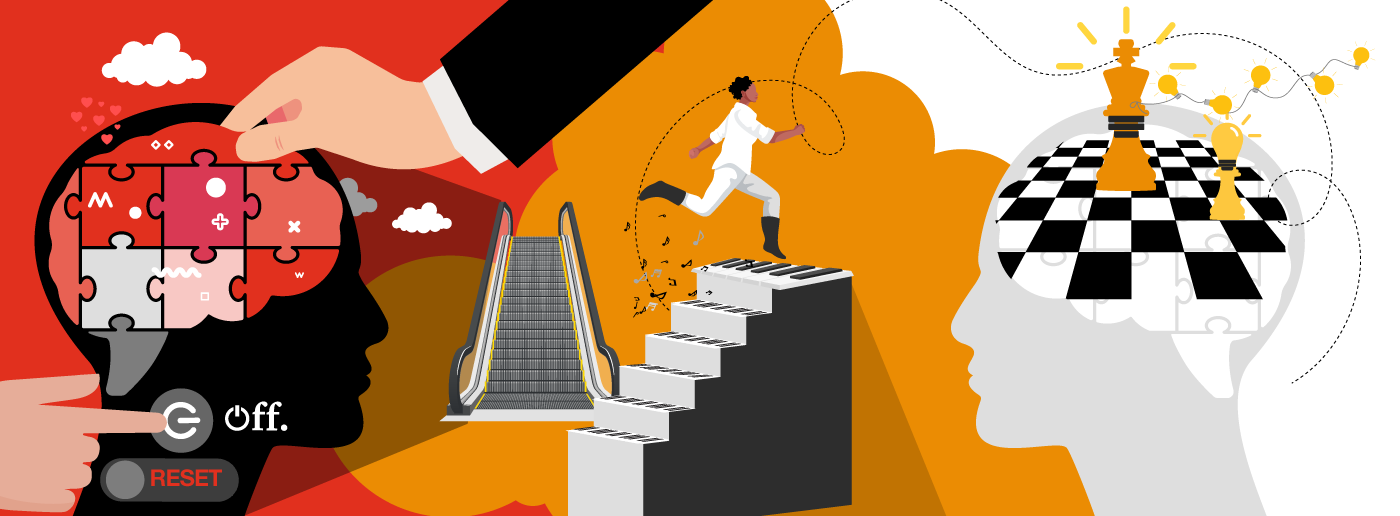Picture this: it’s 2009, and Volkswagen Sweden decides to conduct an experiment on how to influence people’s behaviour in their environment for an ad campaign promoting their new, more fuel-efficient brand.
More precisely, the well-known automotive company wants to encourage people to take the stairs instead of the escalator in a metro station. And so, they turned a normal staircase into a “piano staircase.” This meant that when people stepped on it, they would produce a sound. This simple yet engaging alteration resulted in 66% more people choosing the stairs over the escalator.
This short story illustrates how cognitive biases can significantly influence our understanding of customer behaviour and feedback, potentially leading to aligned or misaligned offerings. In this case, through the confirmation bias, Volkswagen Sweden validated their preconceived notions—that is, that by making the experience engaging and fun, people would opt for the stairs.
Don’t have time to read the whole blog entry? Then watch our “Blog in 1 minute” video for a quick summary of its main points:
However, Volkswagen Sweden may have overlooked other factors influencing this change in people’s behaviour that, if considered, could have led to other, alternative approaches. In addition, the experiment reveals the use of several other biases, such as:
- Halo effect, with the unusual association of a piano and fuel efficiency.
- Selection bias, as the experiment was conducted in a metro station, which may not accurately represent the wider population of car buyers.
- Fundamental attribution bias, where they may have attributed the increase in staircase usage solely to the piano alteration, missing other potential factors such as the novelty effect or even the weather or the time of the day.
- Stereotyping, by assuming that making an activity more entertaining will encourage people to choose the stairs.
As mentioned, cognitive biases, whether positive or negative, can have a significant impact on how you interpret the results of any experiment or prototype. Understanding them is critical to align offerings with the true needs and preferences of your target audience.
This awareness is key in the Customer Experience (CX) field, where innovative design can have a significant impact on user behaviour. In a world surrounded with information and choice, recognising and addressing these biases is crucial to creating effective customer-centric strategies.
Our Experience Centre’s eXperience by Design event explored this topic in September 2023, bringing together specialists and passionate advocates of human-centred design to discuss the persistent challenge of dealing with biases in customer behaviour strategies and decision making.
Our speakers, Jonathan Kafka, Head of Innovation at Baloise LU Assurances Luxembourg, and Tiphaine Saltini, CEO of Neuroprofiler, used magic tricks and a gamification-inspired tool to provide valuable insights and share ingenious approaches to addressing cognitive biases in customer-centric strategies.
In this blog, we explain cognitive biases and their importance in decision making, highlighting key biases relevant to user behaviour and decision making in customer experience (CX) strategies.
We also discuss the challenges that cognitive biases bring, including distorted perceptions, biased decisions and ineffective experimentation, as well as strategies to mitigate these challenges.
Finally, we give you more details about the eXperience by Design event and its contribution to understanding and addressing cognitive biases to create effective customer-centric strategies.
Cognitive biases explained
Cognitive biases are inherent mental shortcuts and patterns of thinking that are influenced by our own perceptions, beliefs, and experiences. They result from the brain’s attempt to simplify complex information processing to enable faster decision making. This, let’s face it, is quite a useful skill to have.
However, they can also cause inaccuracies and deviations from reality that influence our decision-making processes and perceptions of the world around us. Often occurring unconsciously, they can lead individuals to make decisions or interpret information in a way that may not align with logic, evidence, or rational reasoning.
We all have biases, and they permeate every aspect of our lives. While it’s important to note that cognitive biases aren’t necessarily negative in themselves, remaining vigilant in our surroundings, maintaining a constant mindset of observation, and stepping back to reflect before making decisions are crucial strategies.
Even when we acknowledge biases, they continue to exert their influence, making it imperative to be aware of them. In addition, the eXperience by Design event highlighted that our innate aversion to loss often outweighs the satisfaction of gain. Being aware of the products and services on the marketplace that capitalise on customers’ biases is critical to navigating this landscape.
The different cognitive biases
Understanding cognitive biases is essential to building effective customer-centric strategies. Psychologists and human behaviourists have identified and studied more than hundreds of different cognitive biases. Let’s look at some of those that particularly play a role in user behaviour and decision making:
- Confirmation bias: It leads individuals to seek out and interpret information that aligns with their pre-existing beliefs or expectations. In our context of customer experience, this could mean that organisations may selectively focus on feedback that validates their current strategies, potentially missing key areas for improvement.
- Availability bias: People tend to rely on already available information, often recent or memorable events, when making judgements or decisions.
- Anchoring bias: Can occur when someone relies too much on the first piece of information they receive to make a decision.
- Representativeness bias: This involves making judgments about the likelihood of an event based on its similarity to previous experiences.
- Social judgement theory: When a person’s attitude or judgement towards new information or ideas is based on their pre-existing beliefs and attitudes.
- Affect heuristic: Refers to making decisions based on emotions or feelings rather than a rational analysis of the situation.
- Bandwagon effect: The inclination to believe or do something simply because many other people believe or do it.
- Sunk cost fallacy: A person’s tendency to continue investing in something because of the resources (time, money, etc.) already invested, even when it no longer makes sense to do so.
The negative and positive impact of cognitive biases
Cultural and demographic biases, if left unaddressed, can inadvertently exclude key segments of any customer base. To foster inclusivity and authenticity, it’s crucial to remain vigilant in identifying such biases and mitigating their potential negative impact. Only then you can develop customer experience strategies that truly meet the diverse needs and expectations of your customers.
Here are some examples of challenges associated with cognitive biases:
- A distorted perception of user feedback and behaviour: Confirmation bias, for example, can lead organisations to seek out and interpret information that aligns with their existing beliefs about them. This can lead to missing critical insights that could challenge or provide a more accurate understanding of customer feedback and behaviour.
- A biased decision making and strategy design: Anchoring, representativeness and other biases can influence how organisations design and implement their strategies. Relying too much on initial information, assessing the probability based on past experiences, or making decisions based on emotion rather than logic can distort the strategies designed, potentially leading to a less customer-centric approach.
- An ineffective experimentation and testing: Confirmation bias can prevent effective experimentation and A/B testing. If organisations are likely to interpret results in a way that aligns with their pre-existing beliefs, the objectivity and relevance of experiments can be compromised, leading to inaccurate conclusions and potentially ineffective strategies.
- An insufficient understanding of customer preferences: Availability bias, which influences decision-making based on readily available information, can result in organisations not fully understanding customer preferences. Relying too heavily on easily accessible data may not provide a comprehensive view of what customers really want or need.
- An inadequate response to market dynamics: Some biases can lead organisations to make poor decisions in response to market dynamics, focusing on mitigating losses rather than capitalising on potential gains or innovative opportunities.
However, bias can also have several positive effects, and help us make better decisions. For instance:
- Build a link with the affect bias: Create an emotional connection with the audience through the use of personal stories or anecdotes. When we hear a story that touches us emotionally, we are more likely to remember it and the information it contains.
- In education, the primacy and recency effect: emphasising the most important information at the beginning and at the end of a lesson can help students retain this information better.
- In the medical field, the placebo effect can be used ethically to improve the perception of a drug treatment’s effectiveness.
An essential tool in this journey is the practice of reflective and critical questioning. By constantly challenging our assumptions, interpretations and reactions, we create an environment of self-awareness that can reveal potential biases that influence our decisions and perspectives.
Asking ourselves why we hold a particular belief, interpret data in a particular way or are inclined to make a particular choice, helps to identify the underlying biases and ultimately adjust our strategies and approaches to better meet the real needs and expectations of our users.
Hence, embedding a culture of active questioning into our processes is a fundamental step towards navigating cognitive biases and achieving true customer centricity.
How to approach cognitive biases
The best way to handle cognitive biases—whether it be to capitalise on the positive effects or to mitigate the negative ones— involves recognising them better and quicker through strategies such as education, diversified data collection, balanced decision making, incorporating behavioural economics principles, and seeking additional testing and feedback.
These approaches aim to promote awareness and objectivity in customer experience strategy development, ultimately working towards true customer centricity.
Conclusion
We hope that, as we reach the end of our blog entry, you can grasp how fundamental understanding and addressing cognitive biases is to design effective customer-centric customer experience (CX) strategies. The intriguing example of Volkswagen Sweden’s piano staircase experiment illustrates how these biases can significantly influence behaviour and perception.
Acknowledging biases, whether positive or negative, enables the development of strategies that are truly aligned with your customers’ needs and preferences. The eXperience by Design event emphasised the importance of addressing biases when designing successful customer-centric approaches.
To sum up, navigating cognitive biases is a critical step in delivering exceptional customer experiences and fostering inclusivity and authenticity in strategy design.
About the eXperience by Design events
The Designers in our Experience Center always put the customer at the heart of everything they do. With that in mind, they had the idea back in 2021 to bring together a customer-centric community in Luxembourg, with professionals from different backgrounds who share a deep interest in understanding customers and designing exceptional experiences.
Since then, they gather twice a year to deep dive into one topic related to customer centricity. These invitation-only gatherings combine insights from guest speakers with collaborative and networking activities.
In our previous editions, participants have explored the concepts of Customer Centricity, delved into the intricacies of Customer Journeys,adopted a better Customer Mindset as well as stimulated their Customer Creativity before deconstructing the Customer Biases that can influence our decisions.
Hungry for more information about customer centricity and everything that goes with it? Take a look at our eXperience by Design community and receive an exclusive invitation to our next edition. Let’s raise the customer centricity game together!
What we think

In customer experience strategies, understanding cognitive biases and mitigating their potential negative impact is an important step towards true customer centricity. This edition of our eXperience by Design event unlocked our ability to identify cognitive biases and create memorable experiences that serve our users and target audiences.
Coralie Michel, Innovation Specialist, PwC Experience Center, at PwC Luxembourg
As someone deeply immersed in the world of corporate innovation and an enthusiast of magic in my spare time, I’ve come to appreciate the subtle art of leveraging cognitive bias to craft uniquely enriching experiences, humbly acknowledging that it’s the subtlest of nudges that often spark the most extraordinary outcomes.
Jonathan Kafka, Head of Innovation at Baloise LU Assurances Luxembourg


